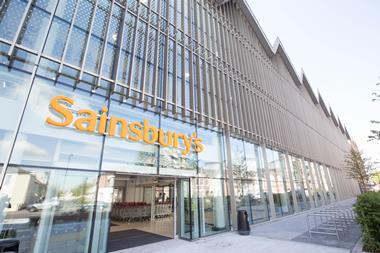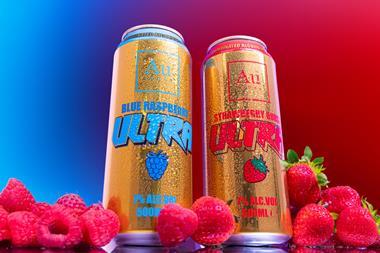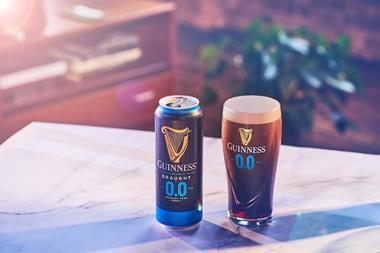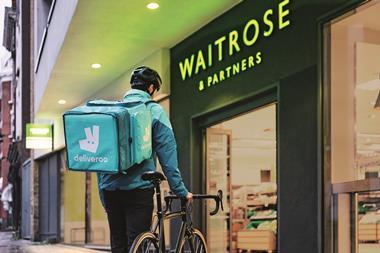Even Sainsbury had only converted 10% of its stores to self-service by the 1960s, but by the end of the decade it had started moving with the times and half its shops had dispensed with counters.
The devoted Sainsbury family were still very much involved at the time and during the decade no other chain could touch it. Although still a traditional company, the firm wasn't adverse to trying out new initiatives; it shook up its distribution systems, opening a massive centre in Basingstoke, and set up a specialist depot for distributing fresh fruit and veg. It also became the first food retailer to install a computer at Stamford House which took over stock control of non-perishable lines.As a result, profits almost doubled.
Sainsbury's own label identity went from strength to strength in the '60s when it introduced about 1,000 own brand lines. By the end of the decade, these accounted for more than 50% of turnover; Sainsbury biscuits had a 65% share of sales, while soft drinks had 85%.
Its Chichester store, which opened in 1961, was the first to sell non food on a permanent basis, and beers, wines and spirits were introduced in the first self-service off licence department in 1962. And, as more married women joined the workforce, it employed growing numbers as part-time workers.
Its heritage and thorough business practices meant Sainsbury was respected by suppliers and consumers alike (its fresh meat was particularly lauded), but it still had a perception of being rather old-fashioned. By 1969 it had even started calling its stores supermarkets, a term it had previously shunned as downmarket.
Tesco was snapping at the heels of its biggest rival during this time, but in the early 1970s was still piling it high and selling it cheap.
The chain was a different breed, however, and operated in the maverick, bullish style of founder Jack Cohen. He was far less concerned with tradition and went against industry opinion by issuing trading stamps which helped to grow share against Sainsbury and Asda.
Acquisitions such as the Victor Value chain helped increase volume, and sales doubled in the first half of the 1970s, but profits fell and Tesco started to look on very shaky ground. Its dramatic turnaround only occured during the latter part of the decade when a new team with Ian MacLaurin as md and Leslie Porter as chairman took over. Together they worked with strategic consultants to relaunch the Tesco business, naming it Operation Checkout. In 1977 it caught much of the grocery market unawares with its bid for greater volume, increased market share, and stronger customer and store loyalty by improving the brand image and store delivery.
It proved hugely successful and was followed by the Discount '78 campaign. By the end of the decade, Tesco had started to discard its cheap n' cheerful philosophy and was looking at quality and service.
By the 1980s, other operators were making headlines too notably, the formidable team of James Gulliver, Alistair Grant and David Webster who had created a portfolio of manufacturing, wholesaling and retailing businesses known as the Argyll Group.
By the early part of the decade, Argyll was operating five fascias Presto, Liptons, Templeton, Galbraith and Hintons and working with three own label ranges. In 1985 it opened four new RDCs, allowing it to double the proportion of goods distributed through its own warehouses and also introduced a total systems approach to store management, which was vertically integrated with distribution systems, to cover replenishment, delivery, labour scheduling and shelf space allocation.
In 1987 Argyll's food division had all but achieved its margin operative of 4%. That year, it bought the Safeway chain and took the brave step of merging Presto's 159 stores into Safeway's 133 stores. The Presto stores were rebranded and a stronger own label range launched. The new store programme was accelerated, fresh and own label products were developed, and customer service programmes were introduced.
By the end of the 1980s, profits had increased fivefold a success story which at that time Asda could only look on with envy; the group had spread itself too thinly across retail and the share price started to plummet.
When Archie Norman took over in 1991 and set his ambitious agenda for renewal and growth, the share price was just 27p and the chain was almost bankrupt.
His formula concentrated on restoring value at the heart of the Asda brand and revolutionising internal communications and motivation. He planned to re-establish Asda's price reputation, improve productivity, develop the own brands and focus on fresh food. The marketing emphasis was also changed to price and a TV campaign was launched in 1992 under the Asda Price slogan.
It worked. In 1995, at the end of a three-year recovery programme, Asda was a much stronger force and boasted customer numbers of more than 5.2 million per week.
During the 1990s, Asda made its mark with a number of innovative and sometimes daring moves: helping to abolish RPM on OTC medicines; building the George clothing brand; launching the takeaway concept Food Express; and using its larger stores to sell non food.
Significantly, it overtook Safeway in third place for market share, with sales up from £4bn in 1990 to £8m in 1998. Its youthful and wacky personality was driven home with stunts such as singles nights and drive-in movies in car parks.
By the time of its takeover by Wal-Mart in July 1999 its share price checked out at 220p some 10 times higher than when Norman took the reins.
{{COVER FEATURE }}
Close menu
- Home
- Retail & Wholesale
-
Products & Suppliers
- Back to parent navigation item
- Products & Suppliers
-
Product Categories:
- Back to parent navigation item
- Product Categories:
- Alcoholic drinks
- Bakery
- Cereals & breakfast
- Cheese
- Chicken & poultry
- Chocolate
- Confectionery
- Crisps, nuts & snacks
- Dairy
- Fish
- Fresh produce
- Frozen
- Household
- Meat
- Own Label
- Sauces & condiments
- Seasonal
- Soft drinks
- Vaping
- Vegan & plant-based
- World foods
- Suppliers
- People
- Reports & Data
-
Topics A-Z
- Back to parent navigation item
- Topics A-Z
-
Popular topics:
- Back to parent navigation item
- Popular topics:
- Cost of living crisis
- Crime
- Deposit Return Schemes
- Finance
- Government & Regulation
- Health
- Inflation
- Loyalty
- Marketing
- Mergers & Acquisitions
- New Product Development
- Sourcing
- Supply chain
- Sustainability & environment
- Technology
- Ultra Processed Foods
- Vaping
- A-Z all topics
- Content by type:
- Events
- Ask iA (beta)
- Subscribe now
Sign in to comment on this article
Not logged in before? Register for FREE guest access today.
You will be able to:
- Read more stories
- Receive daily newsletters
- Comment on stories
Advert















No comments yet